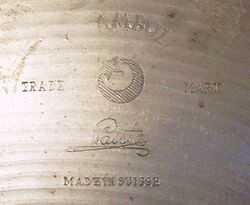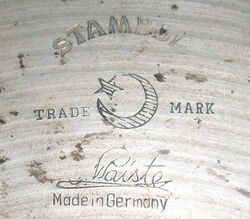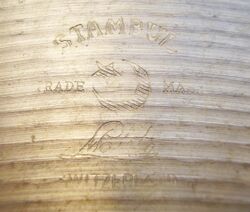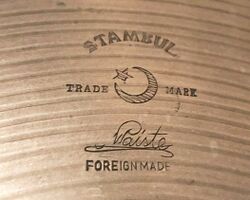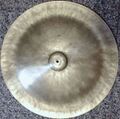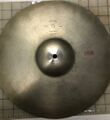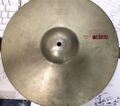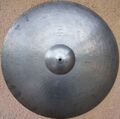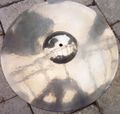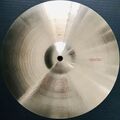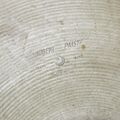Difference between revisions of "Paiste Stambul"
| (11 intermediate revisions by 2 users not shown) | |||
| Line 1: | Line 1: | ||
__NOEDITSECTION__ | __NOEDITSECTION__ | ||
== Stambul NS12 == | == Stambul NS12 == | ||
| − | [[File:Stambul | + | [[File:Stambul blk wht.jpg|thumb|right|250px|]] |
| − | + | [[File:Stambul swiss 1.jpg|thumb|right|250px|"wide stamp" Swiss Made: (1957 to 1958)]] | |
| − | [[File:Stambul | + | [[File:Stambul swiss 2.jpg|thumb|right|250px|"wide stamp" made in Suisse: also 1957 to 1958]] |
| − | [[File:Stambul swiss | + | [[File:Stambul robert p logo.jpg|thumb|right|250px|"wide stamp" Robert's name added above location ]] |
| − | [[File:Stambul | + | [[File:Stambul german.jpg|thumb|right|250px|made in Germany, post '57 after the Swiss factory came online (this is a "narrow stamp" version)]] |
| − | [[File:Stambul | + | [[File:Stambul swiss 3.jpg|thumb|right|250px|"narrow stamp" Switzerland: (late 60's to early 1970's)]] |
| − | [[File:Stambul swiss 3.jpg|thumb|right|250px|Switzerland: ( | + | [[File:Stambul foriegn made.jpg|thumb|right|250px| "narrow stamp" "foreign made" English import, most likely by Arbiter]] |
| − | '''Introduction:''' Late 1930's | + | |
| + | '''Introduction:''' Late 1930's (no documentation)<br> | ||
'''Discontinued:''' 1971 (NS12 version) 1978 (B8 version)<br> | '''Discontinued:''' 1971 (NS12 version) 1978 (B8 version)<br> | ||
| − | '''Background:''' Introduction 1930's (no documented proof) / Transitioned to B8 around 1971: [https://www.cymbal.wiki/wiki/Paiste_Stambul_B8#Stambul_B8 see B8 | + | '''Background:''' Introduction 1930's (no documented proof) / Transitioned to B8 around 1971/72: [https://www.cymbal.wiki/wiki/Paiste_Stambul_B8#Stambul_B8 see the B8 Stambul for '71 and later history]<br> |
As far as the dating and where these cymbals were made, the following provides a basic timeline *(we do not have any documentation that precedes 1950):<br> | As far as the dating and where these cymbals were made, the following provides a basic timeline *(we do not have any documentation that precedes 1950):<br> | ||
| − | 1932-1940 (Estonia)<br> | + | 1932-1940 (Estonia) no records<br> |
| − | 1940-1945 (German occupied Poland)--relocation during WWII, small production, alloy supplies | + | 1940-1945 (German occupied Poland)--relocation during WWII, small production, alloy supplies allocated by the German government<br> |
| − | 1945- | + | 1945-1947 (Germany)--relocation after WWII, no production, war refugees<br> |
| − | 1948-1957 (Germany)--production restarts once again after receiving initial business capital<br> | + | 1948-1957 (Germany)--production restarts (initially in abandoned barn!) once again after receiving initial business capital from new German government<br> |
| − | 1957-1977 (Switzerland & Germany)<br> | + | 1957-1977 (Switzerland & Germany)-- production increases exponentially with the addition of Ludwig distribution in the U.S.<br> |
| − | The Stambul line was considered Paiste's top-of-the-line cymbal prior to the Formula 602 release in 1959, where it took a second place position after that.<br> | + | The Stambul line was considered Paiste's top-of-the-line cymbal prior to the super Formula/Formula 602 release in approx. 1959, where it took a second place position after that.<br> |
Dating and identifying Stambuls, like other cymbals of this time frame are a real challenge, as there are only a few means to physically evaluate a time period. We have provided a few indicators to help narrow down date ranges.<br> | Dating and identifying Stambuls, like other cymbals of this time frame are a real challenge, as there are only a few means to physically evaluate a time period. We have provided a few indicators to help narrow down date ranges.<br> | ||
| − | <b>Indicator #1 Alloy Type:</b> [[Identify_Your_Paistes#Nickel Silver|NS12-Nickel Silver]] was used from 1930's through | + | <b>Indicator #1 Alloy Type:</b> [[Identify_Your_Paistes#Nickel Silver|NS12-Nickel Silver]] was used from 1930's (estimated) or at least from 1948 through about 1971 (B8 was utilized on virtually of the lower line cymbals by about 1972), there many examples of post '71 NS12 Stambuls, most likely these were produced pre '72 and then stamped with ink logos and released post '71.<br> |
| − | <b>Indicator #2 Mounting Hole Size:</b> Most cymbal stands started to be changed/made stronger by | + | <b>Indicator #2 Mounting Hole Size:</b> Most cymbal stands started to be changed/made stronger by the late 1950's or early 1960's, as many drum companies started this trend with their hardware. Todays mounting holes are 1/2" diameter, but previous sizes ranged from 7/16" to 3/8" diameter. This indicates that the cymbal was made most likely prior to the early 1960's.<br> |
| − | <b>Indicator #3 Distinctively Larger Bell:</b> Stambuls had a much larger bell than what is now a common size (see pics below). This is shown in the 1950 and 1952 catalogs, we aren't exactly sure when the downsizing of the bell took place, it's possible that smaller bells transitioned in with the new release of the Stambul 65's in 1965 or earlier.<br> | + | <b>Indicator #3 Distinctively Larger Bell:</b> Stambuls had a much larger bell than what is now a common size (see pics below). This is shown in the 1950 and 1952 catalogs, we aren't exactly sure when the downsizing of the bell took place, it's possible that smaller bells transitioned in with the new release of the Stambul 65's in 1965 or possibly a few years earlier.<br> |
| − | <b>Indicator #4 Colored Ink Labels:</b> ? - 1959: Red "size" in inches followed by the "type/weight" ink stamp at 3 o'clock. | + | <b>Indicator #4 Colored Ink Labels:</b> ? - 1959: Red "size" in inches followed by the "type/weight" ink stamp at 3 o'clock. early 60's - 1973: Red ink diameter/size stamp under the bell until 1973 (or very late '72) and then it changes to Black for the remainder: 1973-1981. 1971: "Paiste" name ink stamp now gets applied above the bell, this included other series, not just Stambul. 1972: Series name ink stamp below Paiste name.<br> |
| − | <b>Indicator #5 Location Name:</b> We believe this can be helpful as an indicator because if the logo had | + | <b>Indicator #5 Location Name:</b> We believe this can be helpful as an indicator because if the logo had no location shown, it was either an earlier model (pre-1957) or one used later towards the end of the production runs (1970-1977). There were 2-3 different location names used for those cymbals made in Switzerland. Germany only used "made in Germany". The following show the variations for Swiss made cymbals:<br> |
"Swiss Made" this is believed to be the first one used out of the factory (1957 to 1958)<br> | "Swiss Made" this is believed to be the first one used out of the factory (1957 to 1958)<br> | ||
| Line 38: | Line 39: | ||
"Switzerland" this was utilized through much of the remaining years (1959 to early 1970's)<br> | "Switzerland" this was utilized through much of the remaining years (1959 to early 1970's)<br> | ||
| − | As far as the embossed Stambul logo, we are fortunate | + | As far as the embossed Stambul logo, we are fortunate that the overall logo style did not change much over the entire life of the Stambul (see logos to the right). It's design uses a large size, hollow block letters with 1 or 2 thin vertical lines through each letter spelling out "Stambul". This name was all set on a curve or arc form above the logo components. Below this was the Star and Crescent pattern that was tilted so that the star was in the 10-O'clock position with varying cross-hatchings through its interior. The words, 'Trade' and 'Mark' were set to the outside of this logo: "Trade" on the left of it, and "Mark" on the right. Underneath this was the signature "Paiste" name, it was actually shown with part of a lower-case "m" at the "P" location, representing '''Mikhail M. Paiste'''. <br> |
| − | *Note: There is one occasion where there is no signature under the logo. Instead, Paiste used the "Robert Paiste" name in a typical type font. | + | *Note: There is one occasion where there is no signature under the logo. Instead, Paiste used the "Robert Paiste" name in a typical type font. |
| − | *Note: Robert Paiste took | + | *After 1957, most Stambuls had a Location name under the signature.<br> |
| − | Provided below is a | + | *Note: Robert Paiste took control of the company in 1957, so it was likely that Paiste had a dedication to him by using his full name on this cymbal. This seemed to only occur at or after he took control of the company, so likely from '57 to '59. |
| + | Provided below is a simple dating chart:<br> | ||
| − | + | Late 1940's - early 1950's :<br> | |
| − | + | Small (7/16") mounting hole, big bell and 'possibly' (5 or 6) cross-hatchings in the star and (13 or 14) in the crescent (thicker than later versions) and no location identified. Additionally, the 'Trade' and 'Mark' are spaced farther away from the logo work during this time frame, we call this the '''"wide stamp"'''.<br> | |
Pre-1956:<br> | Pre-1956:<br> | ||
| − | + | Small (7/16") mounting hole, big bell and no location under Paiste signature, star cross-hatching (7 or 8) and crescent has (13 or 14)(thicker than later versions), wide stamp format.<br> | |
1957 to 1958:<br> | 1957 to 1958:<br> | ||
| − | + | Small (7/16") mounting hole, big bell, location says "Swiss Made", star cross-hatchings (10 or 11) and crescent has (17 or 18) (thicker than later versions), wide stamp format.<br> | |
| − | 1958 or 1959 to ?:<br> | + | 1958 or 1959 to early 1960's?:<br> |
| − | + | Small (7/16") mounting hole, big bell, location says "Switzerland" and lists "Robert Paiste" above, star cross-hatching (9 to 11) and crescent has (17 or 18), wide stamp format.<br> | |
| − | + | Mid 1960's to early 1970's:<br> | |
| − | + | Large (1/2") mounting hole, small bell, star cross-hatching (5 or 6) and crescent has (13 or 14), various locations (Switzerland, Germany or no location), and ink labels present, "narrow" stamp format.<br> | |
Post 1971 and transition into the 505:<br> | Post 1971 and transition into the 505:<br> | ||
| Line 109: | Line 111: | ||
Chinese-style: 15" & 16" Marching china's in pairs, 17" through 20" Concert china's in pairs<br> | Chinese-style: 15" & 16" Marching china's in pairs, 17" through 20" Concert china's in pairs<br> | ||
| + | |||
| + | |||
| + | |||
| + | |||
| + | |||
<gallery> | <gallery> | ||
| Line 120: | Line 127: | ||
File:Paiste 1959 catalog a.jpg|Early 60's catalog | File:Paiste 1959 catalog a.jpg|Early 60's catalog | ||
File:Paiste 63 catalog 2.jpg|1965-67 Catalog | File:Paiste 63 catalog 2.jpg|1965-67 Catalog | ||
| − | File:Early 50s stambul bebop.jpg|"Bebop" cymbal | + | File:57 58 sonor catalog.jpg|'57/'58 Sonor catalog listing Stambuls |
| + | File:Early 50s stambul bebop.jpg|Early 50's "Bebop" cymbal | ||
File:Stambul china early 50s.jpg|Early china | File:Stambul china early 50s.jpg|Early china | ||
| − | File: | + | File:Stambul ns 12 Thin.jpg|1950's "wide stamp" with red ink indicating size and weight - 12" Thin (411g) |
| − | + | File:1950s stambul.jpg|1950's "wide stamp" Stambul with red ink indicating size and weight - 12" Medium (476g) | |
| − | File:1950s stambul.jpg|1950's Stambul with red ink indicating size and weight | + | File:7248309 1654344889.jpg|NS12 "big bell" heavy with original ink |
| − | File: | + | File:Big bell smal bell.jpg|big bell and small bell comparison |
| − | File: | + | File:18-1427-stamp.jpg|"foreign made" stamp used by Arbiter for the English market |
| − | File:Stambul | + | File:Stambul Trixon 50's emboss.jpg| Stambul logo with Trixon stamp |
| − | File: | + | File:Early 50s sonor wide stamp.jpg|Early "wide stamp" logo with Sonor logo stamped underneath |
| − | + | File:PXL 20211210 040754898.jpg|"big bell" "wide stamp" late 40's or early 50's 20" Sonor Stambul | |
| − | File:Ns12 stambul 15 hh.jpg| 15" hi hats | + | File:Ns12 stambul 15 hh.jpg| NS12 mid/late 50's Sonor "script logo" stamped 15" hi hats |
| − | File:Stambul | + | File:S-l1600 (2).jpg|"Sonor" Stambul "script logo" |
| + | File:S-l1600 (1).jpg|"Sonor" Stambul "script logo" | ||
| + | File:16-china-top.jpg|NS12 marching china-metric | ||
| + | File:16-china-side.jpg|NS12 marching china-metric | ||
| + | File:Stambul-china-side.jpg|Sonor marching china | ||
| + | File:Stambul-china-bell.jpg | ||
| + | File:Stambul-china-sonor.jpg | ||
| + | File:17 stambul concert.jpg| 17" concert cymbal | ||
| + | File:Robert paiste stambul.jpg|unique rare early stamp used for Swiss made Stambuls | ||
| + | File:Robert paiste stambul2.jpg|rare early Swiss made Stambul | ||
</gallery> | </gallery> | ||
---- | ---- | ||
| − | Information from: '''[[Paiste Advertising|Paiste | + | Information from: '''[[Paiste Advertising|Paiste catalogs]] Todd Little, Dan Garza<br> |
Return to the '''[[Paiste Series|Paiste Series Portal]]<br> | Return to the '''[[Paiste Series|Paiste Series Portal]]<br> | ||
Return to the '''[[Paiste Cymbal Type|Paiste Cymbal Type Portal]] | Return to the '''[[Paiste Cymbal Type|Paiste Cymbal Type Portal]] | ||
Latest revision as of 11:51, 28 December 2023
Stambul NS12
Introduction: Late 1930's (no documentation)
Discontinued: 1971 (NS12 version) 1978 (B8 version)
Background: Introduction 1930's (no documented proof) / Transitioned to B8 around 1971/72: see the B8 Stambul for '71 and later history
As far as the dating and where these cymbals were made, the following provides a basic timeline *(we do not have any documentation that precedes 1950):
1932-1940 (Estonia) no records
1940-1945 (German occupied Poland)--relocation during WWII, small production, alloy supplies allocated by the German government
1945-1947 (Germany)--relocation after WWII, no production, war refugees
1948-1957 (Germany)--production restarts (initially in abandoned barn!) once again after receiving initial business capital from new German government
1957-1977 (Switzerland & Germany)-- production increases exponentially with the addition of Ludwig distribution in the U.S.
The Stambul line was considered Paiste's top-of-the-line cymbal prior to the super Formula/Formula 602 release in approx. 1959, where it took a second place position after that.
Dating and identifying Stambuls, like other cymbals of this time frame are a real challenge, as there are only a few means to physically evaluate a time period. We have provided a few indicators to help narrow down date ranges.
Indicator #1 Alloy Type: NS12-Nickel Silver was used from 1930's (estimated) or at least from 1948 through about 1971 (B8 was utilized on virtually of the lower line cymbals by about 1972), there many examples of post '71 NS12 Stambuls, most likely these were produced pre '72 and then stamped with ink logos and released post '71.
Indicator #2 Mounting Hole Size: Most cymbal stands started to be changed/made stronger by the late 1950's or early 1960's, as many drum companies started this trend with their hardware. Todays mounting holes are 1/2" diameter, but previous sizes ranged from 7/16" to 3/8" diameter. This indicates that the cymbal was made most likely prior to the early 1960's.
Indicator #3 Distinctively Larger Bell: Stambuls had a much larger bell than what is now a common size (see pics below). This is shown in the 1950 and 1952 catalogs, we aren't exactly sure when the downsizing of the bell took place, it's possible that smaller bells transitioned in with the new release of the Stambul 65's in 1965 or possibly a few years earlier.
Indicator #4 Colored Ink Labels: ? - 1959: Red "size" in inches followed by the "type/weight" ink stamp at 3 o'clock. early 60's - 1973: Red ink diameter/size stamp under the bell until 1973 (or very late '72) and then it changes to Black for the remainder: 1973-1981. 1971: "Paiste" name ink stamp now gets applied above the bell, this included other series, not just Stambul. 1972: Series name ink stamp below Paiste name.
Indicator #5 Location Name: We believe this can be helpful as an indicator because if the logo had no location shown, it was either an earlier model (pre-1957) or one used later towards the end of the production runs (1970-1977). There were 2-3 different location names used for those cymbals made in Switzerland. Germany only used "made in Germany". The following show the variations for Swiss made cymbals:
"Swiss Made" this is believed to be the first one used out of the factory (1957 to 1958)
"Made in Suisse" we've only seen one of these, but assume this was probably another early run (1957 to 1958)
"Switzerland" this was utilized through much of the remaining years (1959 to early 1970's)
As far as the embossed Stambul logo, we are fortunate that the overall logo style did not change much over the entire life of the Stambul (see logos to the right). It's design uses a large size, hollow block letters with 1 or 2 thin vertical lines through each letter spelling out "Stambul". This name was all set on a curve or arc form above the logo components. Below this was the Star and Crescent pattern that was tilted so that the star was in the 10-O'clock position with varying cross-hatchings through its interior. The words, 'Trade' and 'Mark' were set to the outside of this logo: "Trade" on the left of it, and "Mark" on the right. Underneath this was the signature "Paiste" name, it was actually shown with part of a lower-case "m" at the "P" location, representing Mikhail M. Paiste.
- Note: There is one occasion where there is no signature under the logo. Instead, Paiste used the "Robert Paiste" name in a typical type font.
- After 1957, most Stambuls had a Location name under the signature.
- Note: Robert Paiste took control of the company in 1957, so it was likely that Paiste had a dedication to him by using his full name on this cymbal. This seemed to only occur at or after he took control of the company, so likely from '57 to '59.
Provided below is a simple dating chart:
Late 1940's - early 1950's :
Small (7/16") mounting hole, big bell and 'possibly' (5 or 6) cross-hatchings in the star and (13 or 14) in the crescent (thicker than later versions) and no location identified. Additionally, the 'Trade' and 'Mark' are spaced farther away from the logo work during this time frame, we call this the "wide stamp".
Pre-1956:
Small (7/16") mounting hole, big bell and no location under Paiste signature, star cross-hatching (7 or 8) and crescent has (13 or 14)(thicker than later versions), wide stamp format.
1957 to 1958:
Small (7/16") mounting hole, big bell, location says "Swiss Made", star cross-hatchings (10 or 11) and crescent has (17 or 18) (thicker than later versions), wide stamp format.
1958 or 1959 to early 1960's?:
Small (7/16") mounting hole, big bell, location says "Switzerland" and lists "Robert Paiste" above, star cross-hatching (9 to 11) and crescent has (17 or 18), wide stamp format.
Mid 1960's to early 1970's:
Large (1/2") mounting hole, small bell, star cross-hatching (5 or 6) and crescent has (13 or 14), various locations (Switzerland, Germany or no location), and ink labels present, "narrow" stamp format.
Post 1971 and transition into the 505:
- See the B8 Stambul page for '71 and later history
- B8 version, star cross-hatching (7 or 8) and crescent has (13 or 14), some have "Paiste Stambul" in the black ink stamp. End of series run show ink labels saying "Paiste 505" in black at 12-O'clock position under embossed logo. It is speculated that Paiste was just trying to rid themselves of excess Stambul inventory at this time.
As far as Stambul models, weights and sizes, this is what the research has shown (see catalog pictures below):
1950 CATALOG: (all cymbals were made up to 20" in size, there was a special order option for 22")
Concert & Marching (Turkish-style) Medium & Heavy: 12" through 20"
Marching (Chinese-style) Medium with raised edges: 10" through 20"
Hi Hats of 2 types for "Charleston" cymbals (as they were called then): Flat 10" through 14" (strong 'chick' sound) Thin & Medium
Up or High: 9" through 14" (rattling sound) Thin & Medium
Be-Bop (Strange hollow tone/deep, full sound) Thin & Medium: 10" through 13"
Swish cymbals (particular sharp tone) Thin & Medium: 11" through 14"
'Zisch' cymbals (Hiss or hissing beautiful sound) Paperthin & Thin: 10" through 14"
'Gong' cymbals (Strong, full sound) Medium & Heavy: 11" through 20"
1952 CATALOG: (this catalog was expanded and it offered a universal list for help in ordering)
Hi hats (11"-16")
Hiss Paperthin's or Swish Thins: 10"-14"
Thins (13"-14"), and Thin or Medium: 16"-20"
Jazz (Types: Zisch, Swish, Be-Bop and Gong) Paperthin, Thin & Medium: 10" through 20"
Concert & Marching (Turkish-style in pairs) Medium & Heavy: 14" through 20"
Marching (Chinese-style in pairs): 14" through 20"
1965-1969 Paiste (Swiss) CATALOG: (all were made in Thin, Medium or Heavy)
Jazz, Hi-hat, Marching & Concert: 10" through 20", 22", 24" and 26"
Marching (China-type in pairs): 15" through 20"
1968 CATALOG--TRIXON DRUMS:
10" through 20", 22" and 24"
1970 PRICE LIST (European):
Thin, Medium & Heavy: 10" through 20", 22", 24" & 26"
Marching: 14" through 16"
Concert: 17" through 20"
Hi Hats: 13" through 16"
Chinese-style: 15" & 16" Marching china's in pairs, 17" through 20" Concert china's in pairs
Information from: Paiste catalogs Todd Little, Dan Garza
Return to the Paiste Series Portal
Return to the Paiste Cymbal Type Portal


